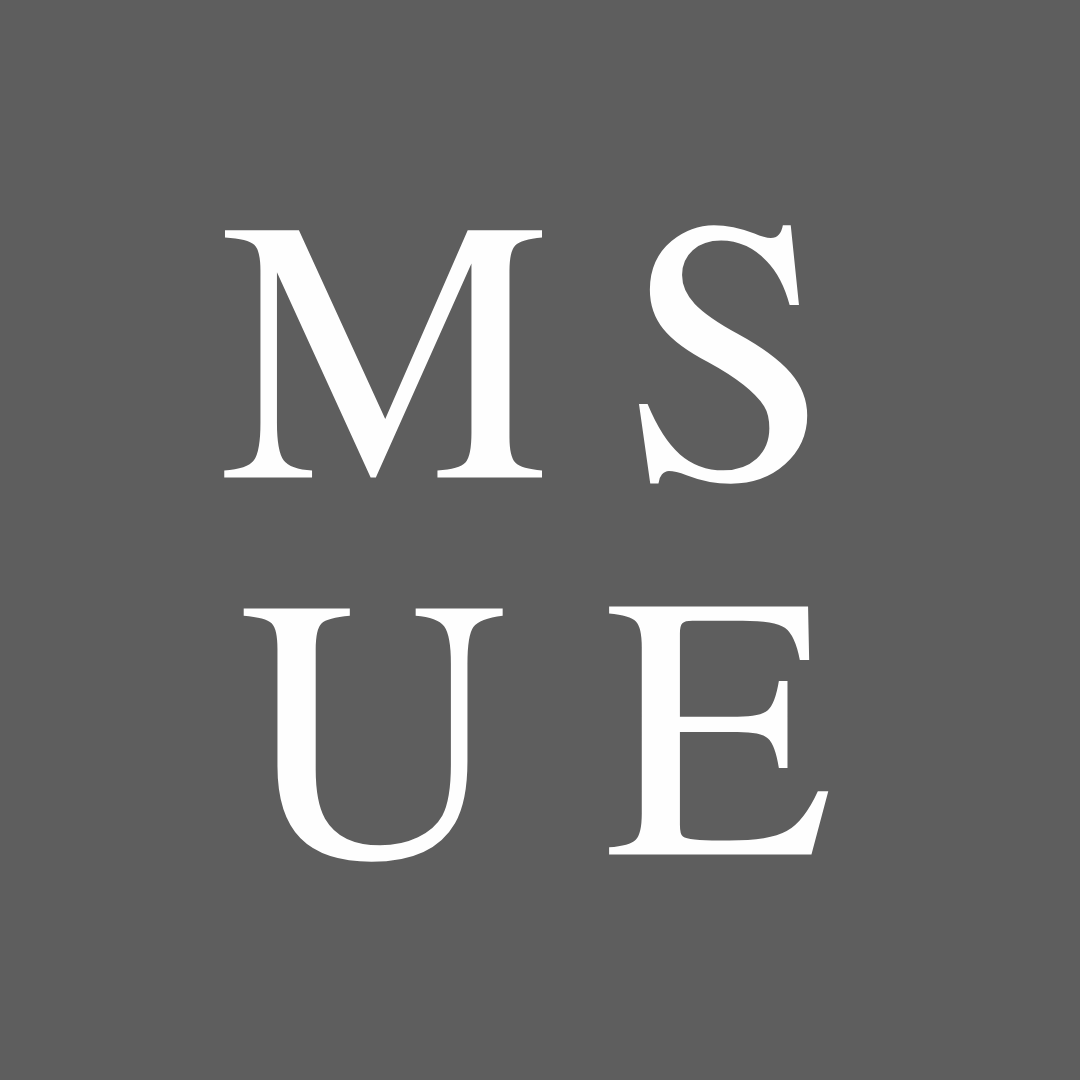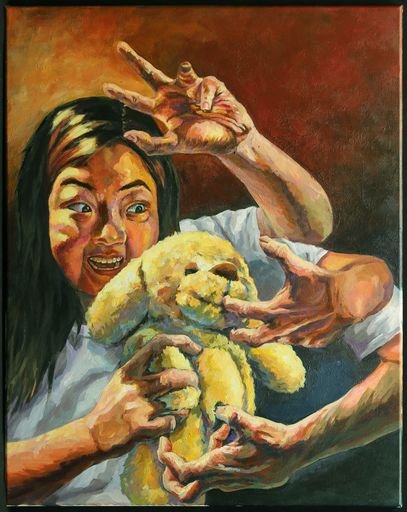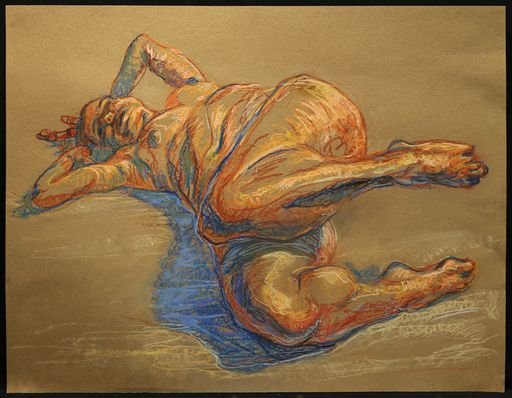interview with julia ouyang
interview with julia ouyang
Christine Baek and Navya Bingi
round 1:
general art questions
Question #1
How would you describe the significance of art in your life?
I distinctly remember when I was 5 years old, I was in an after school daycare program and they [provided] art classes. I simply remember drawing these shoes and toilet paper rolls and they were really bad, but I thought I was like the coolest person ever!
And I think there’s this innate connection I feel when I’m drawing; I feel like I’m communicating with the world around me and also exploring my own identity that’s so unique to art that I can’t do with words or singing. I think that art is one of the only mediums that you can tell something through images and it can communicate so many complex emotions and experiences.
Visual arts is like my first language; I always communicate myself through it. Initially, I started with traditional skills like scenery paintings. But then I started drawing portraits and I really resonated with that and how I can feel this connection with every person I draw. I like to doodle strangers on the street in my sketchbook and they're really bad doodles, but I love experimenting with their shapes, their forms, and also understanding who they are. So through my artwork I really try to portray the struggles, the happiness, the conflicting emotions, but also the broader human experiences we all have.
I just made this six part series about my journey with self-love because visual arts is one of the mediums where I explore my own identity. It was all about how, when I was younger, I had this confidence and love for myself and it manifested in this figurative teddy bear. When I grew older and people chipped away at my self-esteem, I kind of grappled with who I was and my own identity in relation to that figurative teddy bear of unconditional love. I think it became full circle when I realized that love wasn’t this transactional agreement where it’s like “oh I’m gonna be this teddy bear for you, you’re gonna be this teddy bear for me”, but instead out of the context of all of this, it’s just part of life. It was really hard to find self-love for myself and I wanted to portray that in my artwork. The issues that I tackle in my artwork is just my own experiences and how I see other people. Recently, I’m really into contour drawing and lines that look accidental or look messy and also have so much emotion behind them with their curves and edges. I just love drawing figures because I relate to them.
Julia Ouyang | Dissipating, color pencil, charcoal, and pastel
“Through my artwork I really try to portray the struggles, the happiness, the conflicting emotions, but also the broader human experiences we all have.”
Question #2
What classes have you taken? Which teacher had the greatest impact on you?
One of the teachers that was the most influential in my Visual Arts is Ms. Clawson. She has continually supported me since freshman year and, even when I was going through it [in] sophomore year and feeling really exhausted and lost and anxious, she said, “Hey, you can do this; you can challenge yourself with different types of art mediums. You can explore your art style.” And she consistently supported me in doing things outside of school: GHP, joining National Art Honor Society, a lot of art competitions. She’s always been there and we text each other all the time and I send her my art. And she’s like, “Oh, wow! Great! That’s fantastic!” It’s a really special relationship that we have.
At Northview, I took Intro to Art and Graphics Design 1 freshman year, Drawing and Painting 1 and 2 sophomore year, and then AP Studio Art 2D-Design junior year. I’m not taking an art class right now because they didn’t offer AP Art History. I’ve taken those classes and was really adamant about continuing my passion in Visual Arts throughout high school.
Question #3
What is your favorite medium and why?
“Using that paint and a simple brush, I can distort reality and create my own vision of my own experiences.”
I’ve used many materials, from basic pencils and pens to paint, acrylic, and oil. I think acrylic paint is one of my favorite mediums because of how quick it dries and also how pigmented the paint can be. Using that paint and a simple brush, I can distort reality and create my own vision of my own experiences. I think using that mark making and really weird techniques is how I’m so attracted to acrylic paint because it’s very unique.
What medium would you like to become more familiar with?
I want to be good at oil paint. I made one piece, and it was so fun and experimental. [Oil paint] really challenges you to be deliberate about your actions because oil paint takes forever to dry-- I think it takes three weeks to fully dry. So if you mess up, it’s just part of the painting and you have to wait until it dries down to fix it. I think [oil paint] is fun when experimenting with your own art style. The brushstrokes are both accidental and deliberate. It’s a cool medium to play with.
Question #4
What led you to pursue art?
Julia Ouyang | Focus, watercolor
Julia Ouyang | Endurance, acrylic paint and pebbles
I’ve always taken art classes, so it was always part of me. But I honestly didn’t view going into art as a career until high school and I was like, “Oh my god, I don’t know what I’m doing.” I really thought I wanted to be in Business, like “I should be an Econ major.” I’m in marketing classes right now!
I think the turning point was-- I distinctly remember going to the Yayoi Kusama exhibition at the High Museum in (I think it was) my sophomore year. And I was looking at all this art and I barely got into the exhibition because we couldn’t find tickets online. It was five days before New Years’. Tickets were like $300, and me and my dad were trying to go. We came early, thinking “maybe, we can get an early ticket.” But all the tickets sold out by 3 AM and we were there at 6 AM. It was so stressful and we were just like “please, someone, give us a ticket to get in.” Then, this one family walks by and this lady says, “We got this extra ticket because my daughter’s friend couldn’t come.” My dad ran up and was like, “Thank you so much!” She gave it to us for free! So my dad couldn’t come with me. I was there by myself, 15 years old, standing in this crowded museum.
Looking at Kusama’s artwork was really inspiring because I saw myself in it. Because she’s an old Asian woman-- she’s like 90 years old or something-- but I saw [art] was a possibility. And it’s contemporary art; she still makes art to this day! She’s obviously profiting off of it and I saw how I could create contemporary art where I could become an artist and not have to succumb to the stereotype of “The Starving Artist.” [Kusama’s] installations were crazy, and there was this one room where-- well, she’s famous for her infinity mirrors-- but the last room was the Obliteration Room where everyone gets a pack of five circle stickers and you just stick them all over this room. And it’s filled with these rainbow dots and it was an insane experience. It sounds really lame, but it was so important to me because [I realized] I could be an artist, I could be like her.
Julia Ouyang’s…
inspiration
inspiration
inspiration
inspiration inspiration inspiration
I really love Amy Sherald's work because she tackles contemporary race issues through her paintings and they seem so simple like “Oh, it’s a black girl in a blue sweater against some pale background."
Looking at her artwork and her portraits, I think, speaks most to me because it really explores the ambiguity of race and how we view each other and I feel connected to every single person in her portraits.
I’m really into Barbara Kruger’s work because it plays into graphic design, consumerism, and our current human condition. I only learned about her a couple years ago when I was watching the Patriot Act; she was talking about how Supreme ripped off her artwork. I was looking at her piece of art, “I shop therefore I am”, and I was like that’s insane! That’s insane to think about consumerism ingrained in human condition and it really inspired my later work. I recently just did some pieces about consumerism because I think about art and how it can impact us socially and how art doesn’t just exist in this vacuum where people just look at pretty things.
round 2: julia’s art process
Most of your art pieces are self portraits…
What is unique to self portraits? How would the meaning of your artworks change if you depicted a different person?
I think self-portraits are really unique in that I explore my own identity through my artwork. Beyond the surface level, I know me best and that’s how I draw, how I paint. Plus, it’s also really difficult to find people who’ll pose in pictures for you. You have to be like, “Hey, can you look mad and I can paint you?” So, yeah, it’s my own face and body that I’m most familiar with.
Drawing portraits of other people is a very different experience because you get to understand other people like how you understand yourself. I painted this portrait of Janice, Yena, and Noreen. They’re my friends and I know them on that personal level, but also, in the portrait, I’m distorting their arms and changing their facial features. I’m exploring different skin tones, the depth and shadows and color schemes. It’s through this medium of portraiture that I understand other people and how I view myself. I can view [my portraits] through my relationships with [my friends] or in complete absence of relationships like when I’m drawing strangers.
Julia Ouyang | Infatuation, acrylic
Which art piece of 2020 was the most fun and/or most challenging to create? Why?
I talked about consumerism earlier, and I made this short film about it. [The film focused on] my relationship with consumerism and how it’s so ingrained in my own identity and other people’s [identities]. I feel my life is just buying, using, and abandoning material objects, so I really wanted to try this new medium of filming. It was really challenging at first because I felt so socially awkward [while] filming. I was like, “This is so weird, just holding my iPhone and filming things at Target.” It was just a very different experience from being at a studio. But when I got down to it and I started working on Adobe Premiere Pro and starting making the video itself, it was really cool to see how I could change perspectives, how I could distort digital media.
I ended up making this board of receipts that had my face on them, and I did that through Adobe Illustrator. It was kind of like a self-portrait, and it was cool to change text and typography to portray myself in a digital sense. I’ve only worked with traditional media before and that was one of the reasons why I’m applying to college with a Digital Medium major, so I can explore more of technology.
Julia Ouyang | Deconstructed, acrylic on foam board
Describe your thought process on which colors to use, the specific style of art, the message to portray, techniques, etc…
It always starts with me thinking, “oh my god I need another art piece for my art portfolio." I’m just obsessed with this one type of style or this subject. So I either see it around me in the world or I scroll on Pinterest and think “wow, that’s cool!” and I fall in this rabbit hole. I have this sketchbook with me, and I’m just writing random ideas in it like what do I want to portray, what kind of emotions does it go through, what’s the deeper meaning of what I’m creating. Then I think about exploring and experimenting with new mediums like, “ok I’ve done pencil, I’ve done watercolor.” How can I change that? How can I mix them together? How can I change something that develops both by art style and also the message I’m portraying. If I’m doing something so realistic, am I going to choose pastel over watercolor? Probably not.
I made a drawing of a bicycle in my messy garage and it was a contour line drawing that I did for AP Art. My teacher looked at it and said “hey maybe you can do something with the background?” We thought about it and I was thinking what new tools can I use? I had my dad help me; he held a bicycle over this large piece of paper. Then I dipped the tire in the paint and rolled it over the paper and used that as the background for me drawing. My art process is either really disorganized or really deliberate. But in the end I make sure that it feels cohesive and natural.
Julia Ouyang | Abandoned, mixed media
If you were showing someone your art for the first time, which piece(s) would you choose?
I would definitely show them my piece of this naked woman laying down. Because I really wanted to emphasize, through that drawing, the curves of her body and the deeper ways you can portray shadow and light through colors and visual textures and scribbling.
It was a really important piece to me because it showed me that I can try this crazy thing and it kind of works. [This piece] also got me thinking about bodies and portraiture in a different sense. It really portrays the art style that I have now.
I also have this piece, “Overgrown,” which is a watercolor with roots coming out of my head and beneath me. It was another self-portrait that I think really portrayed my turmoil and the stressful emotions I had sophomore year.
It also showed how I incorporated both traditional medium and watercolor with this surreal feeling of roots coming out my head, nerves entangling around me. It was fun to experiment with something more like a fantasy.
Julia Ouyang | Overgrown, watercolor
Julia Ouyang | Reclined, chalk pastel
How do you incorporate current art trends into your artwork? Do you tend to do a lot of research to familiarize yourself with different trends? Or does your previous experience mostly guide you?
Moving into graphic design, installation artwork, and contemporary artwork is where I see myself going in the future. I’ve always been scared of moving into the technology medium because I’m pretty comfortable with painting and drawing; I think that something that really draws me to certain colleges or major programs is the fact that I can experiment with audio, text, fonts, graphics, movement, and animation because of how it transcends what traditional media can do. You can experience something or be there to see something and feel those emotions in time and space.
One artwork that comes to mind is Gretchen Bender’s Dumping Core, in the MoMa. It’s basically thirty TV monitors that are blasting techno music and there’s these fast graphics moving across the screen. She made this back in the 80s, but it really speaks to how commercialized these logos and graphics are and how pervasive they are in our digital dystopia right now. I want to create art that addresses social issues and also becomes an artwork that you can experience in real time.
Web Page Redesign by KAYLYN ZHONG









